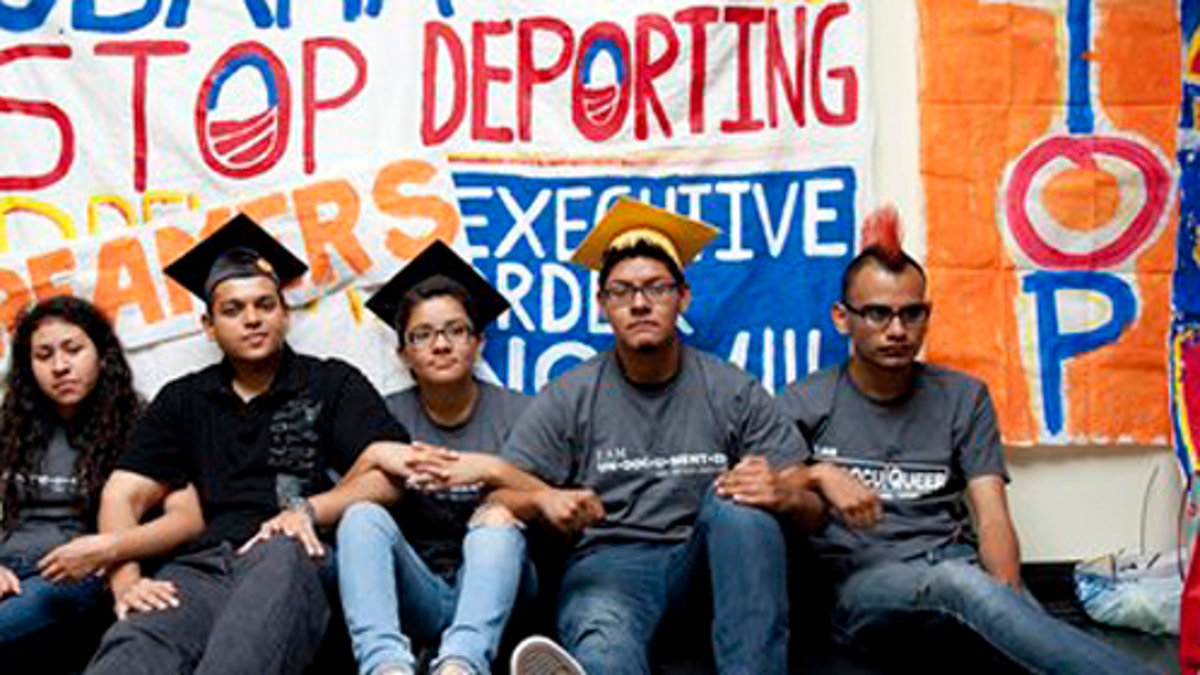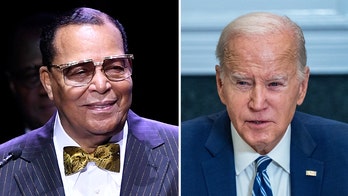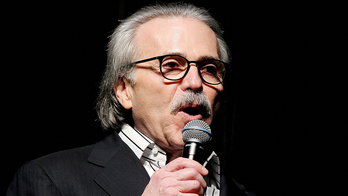
From left, Myisha Areloano, Adrian James, Jahel Campos, David Vuenrostro, and Antonio Cabrera camp outside of the Obama Campaign Headquarters in Culver City, Calif. in protest of President Obama's immigration policiesand in hopes of getting him to pass an executive order to halt discretionary deportation on Friday, June 16, 2012. President Obama eased enforcement of immigration laws Friday, offering a chance for hundreds of thousands of illegal immigrants to stay in the country and work. Immediately embraced by Hispanics, the extraordinary step touched off an election-year confrontation with congressional Republicans. (AP Photo/Grant Hindsley) (Associated Press)
First there were the DREAM 9. Now there were the DREAM 34.
They are two groups of immigrants who in July, and last month, respectively, approached authorities at the Texas-Mexico border to protest U.S. immigration policies and ended up adding a new dimension to the fight for more flexible laws for the undocumented.
And just as with the first group, the DREAM 9, so named because there were nine people who surrendered to U.S. authorities at the border and requested political asylum, the second group is generating a mixed reaction from immigration advocates.
Many praise the 34, who marched across the bridge connecting Nuevo Laredo, Mexico and Laredo, Texas on Sept. 30, knowing they did not have the legal status to enter the country. Others, including U.S. Rep. Henry Cuellar, a Texas Democrat whose district includes the entry point the DREAM 34 crossed, said they are undermining efforts to improve the immigration system.
The immigrants – all of whom were Mexican, except for one from Peru – hoped to reunite with their families and draw attention to others like themselves who were brought to the U.S. illegally as children, but who were not present last year when the U.S. tweaked its immigration policy offering them provisional legal status to remain.
We DREAMers have always pushed the envelope -- since we first starting coming out in public and identifying ourselves as undocumented immigrants. The [older, traditional] advocates said to us "Don’t do it, you could hurt yourselves."
All members of the first group, which was held in a detention center for about three weeks, were released pending a decision on their political asylum requests. Most of the second group remain in detention while they try to establish a credible fear of persecution if they return to their homelands.
“All 30 of these DREAMers initially came to the United States before the age of 16, they all grew up here in the states and consider America to be their home,” said Mohammad Abdollahi, a founder National Immigrant Youth Alliance (NIYA), the organization that coordinated the first and second crossings, in a widely-circulated email about the protest. “Different situations forced some of them to leave, while others were deported; all of them hope to be allowed to come home so they can take part in the American Dream.”
A twitter hashtag, #bringthemhome, and several websites have been set up in support of the two groups. They say they are heroes because of the huge risks taken to bring an end to deportations and call attention to the need for immigration reform.
Cesar Vargas, an undocumented immigrant from Mexico who came when he was 5 years old and is with the national group DREAM (DRM) Action, said that the DREAM 34, like the DREAM 9, simply deviated from the status quo way to fight for immigration reform.
Vargas, who is 30 and lives in New York, said that critics in the immigration reform advocacy group simply are unaccustomed to the way the two groups, and younger undocumented immigrants in general, have chosen to fight for the same things.
“We DREAMers have always pushed the envelope — since we first started coming out in public and identifying ourselves as undocumented immigrants,” said Vargas, a graduate of the City University of New York School of Law. “The [older, traditional] advocates said to us ‘Don’t do it, you could hurt yourselves.’”
“Most advocates focus on legislative and executive efforts to fight for immigration reform,” Vargas said. “DREAMer advocacy focuses on another approach, that’s unsettling to other advocates because they’re very constrained to the limitations they’re used to.”
Human rights attorney, and supporter of the DREAM 34, Bryan Johnson, said that the immigrants simply are taking the fight for all immigrants up a notch, and that they should be commended.
“The DREAM 34 is not about immigration reform,” he said. “Rather, it is a direct effort to advocate for the rights of immigrants, particularly those of DREAMers, who have been repeatedly praised by the very establishment that is now currently opposed to their return to the U.S.”
“DREAM 34 are fighting the system that destroys millions of families through deportations," Johnson added, “causing indescribable tragedies on a daily basis. They’re cutting through the convenient veil of reform to show the truth."
A bipartisan comprehensive immigration reform bill passed in June in the Senate, but the House has addressed the issue in fits and starts. Conservative members in the House say they will not rubber-stamp the Senate bill, which both tightens border security and interior enforcement, and allows a path to legal status for undocumented immigrants who meet a strict set of criteria.
Conservative Republicans in the House, however, vow not to pass any measure that would provide “amnesty” to people who are here illegally.
Critics of the DREAM 9 and DREAM 34 say the two groups have gone too far.
Some critics, including people – such as lawmakers and some DREAMers – who have been strong proponents for an immigration reform law that would include a path to legal status for undocumented immigrants, have gone as far as calling the actions by the DREAM 9 and DREAM 34 publicity stunts.
“They’re hurting our cause,” said Miguel Angel Lopez, a 25-year-old undocumented immigrant who lives in California and who came from Mexico when he was 15. “With their tactics, they’re hogging the spotlight for themselves and taking away from the momentum for immigration reform.”
Lopez said he has not returned to Mexico because he has relatives who have been killed there and, fearing for his own life, he does not want to jeopardize any chance of eligibility to legalize his status. Obtaining political asylum still is difficult for people from Mexico, despite the well-known high rate of violence tied to drug cartels.
Lopez is awaiting documents from Mexico, he said, to apply for a temporary legal status program that the Obama administration announced last year for undocumented immigrants who were brought here as minors.
“Many of these people returned to Mexico on their own, and now they demand political asylum, and they get things they don’t really deserve, like work permits, while they wait for decisions,” he said. “They’re taking advantage of something, political asylum, that I don’t feel they really qualify for.”
Cuellar said that he understands their concerns about the record deportations that have occurred under the Obama administration, and their dedication to keeping immigration reform on the public radar.
“But I don’t agree with those tactics,” said Cuellar. “In my opinion they are counterproductive, you take focus off what we’re doing and [give ammunition] to the Republicans who are more conservative who then say ‘See how radical they are, they all just want open borders.’”
Abdollahi and other supporters of the DREAM 34 have assailed Cuellar for what they say is his overly harsh criticism of their request for political asylum.
“Instead of supporting the DREAMers and asking for them to be reunited with their families, Rep. Cuellar has come out against them,” said Abdollahi in an email to supporters. He's gone on the record with media to say that the families are being ‘exploited.’”
The email urged DREAM 34 supporters to bombard Cuellar’s congressional offices with calls.
Cuellar said the hostility toward him is baffling.
“I’m supportive of immigration reform,” he said. “I was fighting for it when [senators] McCain and Kennedy introduced their bill. I have fought for the DREAM Act. I have written letters to the president urging him to use his discretion to help young immigrants. They’re going after people who support immigration reform. At the end, we all want to end up in the same place.”
David Leopold, a past president of the American Immigration Lawyers Association, and a critic of the DREAM 9, said the DREAM 34 are being manipulated by those who organized the crossings.
“It’s people who send other people out into danger, including a minor, while they sit back in the comfort of the United States,” said Leopold, who came under fire when he criticized the DREAM 9. “They were put in danger. They were taken to Laredo, which was a cartel-driven town. There were murders there.”
Leopold said advocates are needed in the fight in Washington D.C., where legislation that could bring about the changes the DREAM 9 and DREAM 34 can be written.
“The real effort is the one that was made by people like the people who held a march on the National Mall this week, and took part in acts of civil disobedience, to get Congress to move a bill – that’s where history will be made,” he said. “It will not happen because of political theater at the border.”
The DREAM 34 protesters say they missed out on a change to U.S. immigration regulations in June 2012 that gave deferred action – essentially a two-year reprieve from deportation – to immigrants who were brought to the country illegally as children.
Those who were in the U.S. at that time and met a list of criteria could apply for a renewable two-year deferment and work authorization.
The immigrants who participated in the Sept. 30 protest said they returned to their countries of birth before that announcement was made, in some cases just days before, making them ineligible.
The common thread in their credible fear interviews this week was that their U.S. upbringing made them stand out back in their birth countries (Mexico and Peru), and that distinction makes them vulnerable targets for extortion and kidnapping.
Many have stated other grounds for their fears as well, including persecution of gays and lesbians, family members killed by organized crime, mistreatment of indigenous groups and gender-based violence.
The Associated Press contributed to this report.




